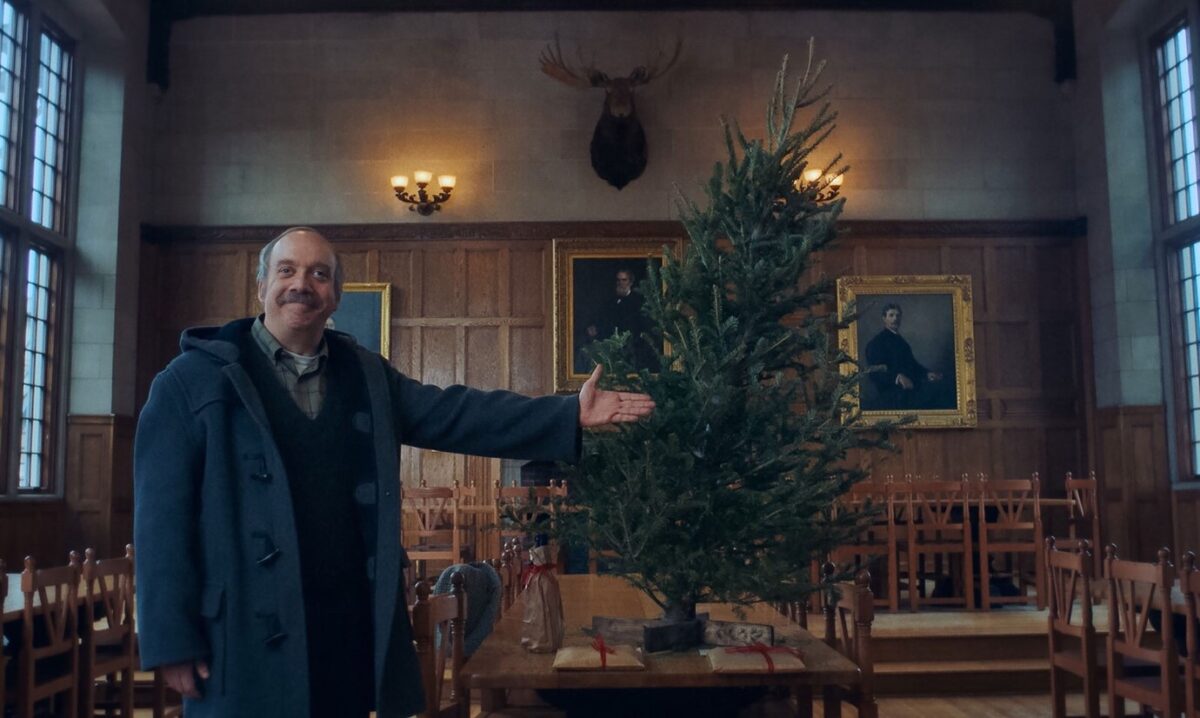The Holdovers (2023), the latest film by Alexander Payne, after a screenplay by David Hemingson, is set in a New England prep school during a snowy winter break, on the backdrop of the 1970s. Paul Hunham (Paul Giamatti) is the professor who has to supervise a handful of boys who have nowhere to go for Christmas. Angus Tully (Dominic Sessa) is the only one of the five who will ultimately remain on campus over the holidays. Mary Lamb (Da’Vine Joy Randolph) is the school’s cafeteria manager who has her own reasons for not celebrating with her loved ones. The three of them are The Holdovers. The arrogant teacher whose whole life is the school, a world that feels comfortable and safe, a world that feeds his intellect but keeps him isolated from the outside world, even if by choice. The smart but misunderstood boy, a misfit who would do anything to be with his family. The mother who has lost her son in war and still very much feels his presence in her life, and she always will.
“Yeah, well, friends are overrated,” Angus tells one of the younger boys, trying to comfort him when the boy confides in him that he misses his family and that he has no friends. That is a great line and I also find it to be key in the film. Because, in the end, these three disparate and differing characters, who have to stay together in spite of themselves, will find a way to be together and get something out of that which will help them move forward. But the storytelling, invisibly woven together by artists of so many crafts, takes time, as it should. It takes time to introduce us to the characters that Paul, Dominic and Da’Vine Joy so earnestly bring to life, let us follow them around and finally reveal their innermost thoughts, demons and dreams.
Alexander Payne’s uncanny vision makes sure to avoid sentimentality and to remain honest to the very end, by steering from humour to drama and back again. The Holdovers is a film interested in human beings and allows room for everyone to behave in an unconforming manner, to disagree and still find a way to stick together and like the person next to them, on a different level, a more human level. I think we miss that in human relationships on screen, probably in life as well. We want to be “crying laughing loving lying”, sometimes all at once, at the same time with Paul and Angus and Mary. The film doesn’t offer a clear-cut solution for each of its character’s problems, but they become a little more unfraid of navigating life with everything it has to throw at them. There is a great truth that resides in that. The cold of the wintry backdrop suddenly becomes enlivening.
Production designer Ryan Warren Smith, whose films include Kelly Reichardt’s Wendy and Lucy and Andrew Haigh’s Lean on Pete, among others, takes us behind the scenes to see how the movie was made and walks us through the instinctive choreography of collaboration. We also talk about the transportive recreation of the 70s and settling the characters, and us the viewers, in that world, about the movie theater that he grew up with, and The Holdovers scene that we both absolutely love.

Fist of all, Ryan, I would like to congratulate you on your work on The Holdovers. This was your first film with Alexander Payne. How did you get to work with him?
This was my second project with Alexander, our first project we had prepped and conceived and were 3 days out from shooting fell apart. We were so heartbroken. We kept talking and he eventually sent me The Holdovers, which I was very excited to read.
I got to work with Alexander on the first one, as he was looking for a new PD, as the one he had used for ever had retired. Alexander had been given a stack of resumes. Alexander doesn’t watch a lot of modern films, but had recently seen a film I did at Telluride, called Lean On Pete, which he loved. We set up a FaceTime call and within minutes we were laughing and very in sync with how we like to work, how we like to approach fictional storytelling with documentary senses.
Have you always wanted to work in the film industry? What drove you to be a production designer?
Yes, I told my mom when I was 7 that I was going to make movies when I got older. It’s been a lifelong dream. I made movies with my friends growing up, and was just always obsessed with movies from a very young age. When I was younger, I thought I wanted to be a director, but once I got on to professional sets as a Production Assistant, I learned very quickly that I didn’t want the main attention being on me, and the Art Department would be a better fit. I’ve always liked being in the background with not too much attention brought on me. I loved characters and character development so much that I naturally gravitated towards the Art Department where the world building and character set pieces were.
So cinema had an important role in your upbringing. Could you tell me a memorable movie experience from when you were young or which were the first films that had a lasting impression on you?
Yes, when I was 8 years old I got a VHS copy of Stand by Me for Christmas. It was a film I had seen and loved, but when I got my own copy I watched it over and over over. I couldn’t watch it enough. I started to realise that it must have been shot out of sequence, which blew my mind. Shortly after this, I started making movies with friends, using a friend’s dad’s camera. I continued this into high school where we would make movies, and took a AV class where the teacher watched one of my films and encouraged me to keep making them. That was gold to me. At this point, the films that impacted me the most were The Shawshank Redemption, La Haine and Natural Born Killers.
What was the starting point of your work as production designer on The Holdovers, in creating, or recreating, this believable and authentic world of a New England boarding school, set in the 1970s?
My starting point before Alexander and I went out and Director Scouted was to jump into research, and find as much information and photographs from the time and area. From there, I created a lookbook, which has a lot of these reference photos, along with colours, and tone references for the film. That way, when he and I start scouting, we have a guide to go by.
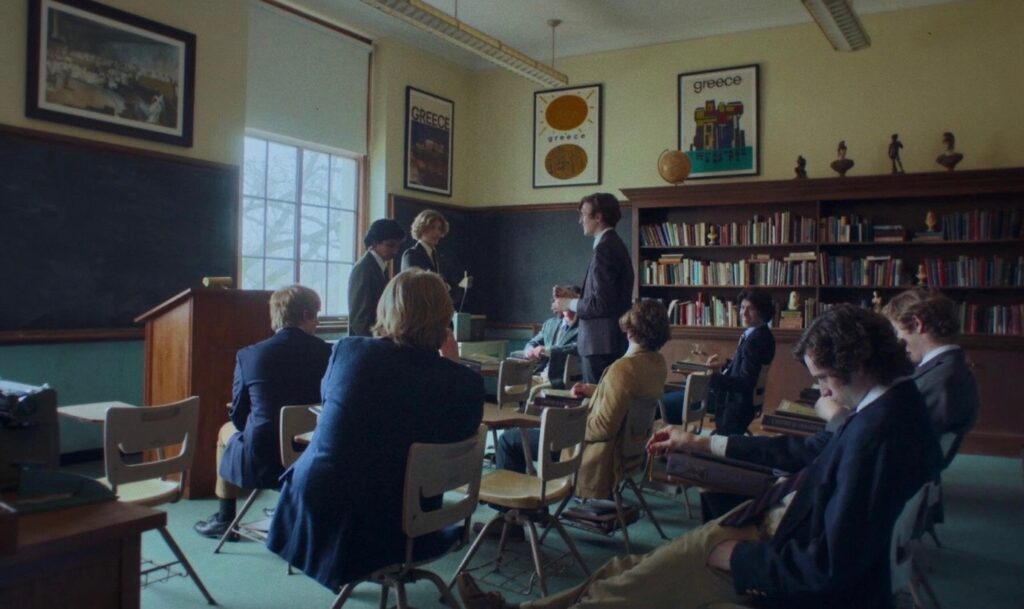
Thank you for showing me the lookbook. There is a clear vision of the film there. And I think that also speaks about that approach to fictional storytelling with documentary senses that you were mentioning earlier. There is a realism to Alexander Payne’s films, they are historically accurate. When you are working on a film, do you usually have a strong design base early on to keep referring to and to keep the look of the film true?
Yes, very much so. I always dive in and do a ton of research, and pull a lot of reference photos. This always becomes my guide as I’m a production designer that never wants to look flashy or stylised. I always want things to look and feel real, above all else. I strive to be invisible, so the viewer is never taken away from the story. My lookbooks help tremendously with this.
Did you come up with the red yellow green colour palette? In what stage of the production design do you also consult with the costume designer?
Yes, once Alexander and I started picking schools, we realised how much dark brown wood was used in them. Alexander was very afraid of making a brown toned film, so I picked these classic colours of the time period (mustard yellow, navy blue & maroon – all faded, nothing too bright) to offset all the brown wood tones. I started speaking to Costume Designer Wendy Chuck as we picked locations, as I start before her, and could start sending her location photos and colour thoughts.
I’ve just realised that there is also a Barton Academy emblem somewhere, I think it’s also on one of Paul’s notebooks, if I recall correctly. Who designed it?
Yes! We used this on the tests, at the school Headmasters Office, and on the wardrobe. Nate Carlson was our incredible graphic designer on the film. He’s worked with Alexander on all of his films for 20+ years. He’s so talented and funny, and he and Alexander have a beautiful shorthand that proved invaluable on the project. Nate also designed the vintage studio logos and movie posters.

Was it from the very beginning a thing about finding the right places to begin with or did you also have to build some sets in order to get what you were looking after?
Since Alexander wanted this to feel like a film that was created in 1970, we wanted to find all real locations, and avoid doing any big builds on soundstages. Alexander fights for a lot for prep so we had time to scout a ton, and find all practical locations to shoot in. We did build set pieces to hide non-period within these locations. We also built the bar in the bowling alley, as this did not exist.
In the campus, we have the lecture halls, the dorms, the principal’s office, the staff offices, Paul’s quarters, and Mary’s, the infirmary, the kitchen, the dining hall, the gym, the park-like settings, the sports field, and I am sure I am missing out a few. How did you put all these pieces together to create Barton Academy?
This was the most important and difficult part of the project, as we knew not 1 school would have everything we needed for the time period. We ended up shooting at 5 different schools to make up our Barton. The key to this was finding locations that feel like they could be in the same place, and then using paint and set dressing to tie them all together.
Where did you film the exterior of Barton Academy?
We filmed the exteriors at two of the schools: Northfield Mount Herman & Deerfield Academy.
The Holdovers is not only a movie set in the 1970s, but it looks and feels like you are stepping into that world watching the film. The filmmaking style, the sense of story, of character, the rhythm of the film, it has its own unique look. The beauty of The Holdovers is actually that it’s its own thing. But I would like to ask: did Alexander Payne show you any films as reference?
Yes, many. We would watch tons of films together in prep, and then, when more people arrived, we’d have a weekly movie night where we would watch a film from the era. Our main influences on the look of the film were Hal Ashby’s The Last Detail and The Landlord.
Production design is first and foremost meant to create a detailed fictional world that would help the characters inhabit that world. Many of the props, for example, remain in the background and are hardly noticed by the audience although they may be of paramount importance for helping the actors get into a certain setting and atmosphere, into character. Were there any particular little things, period props that you used to help define the image of the protagonists? And I am especially referring to Dominic, who is a newcomer, and so marvelous in his role.
Yes, many. Especially in Paul, Angus and Mary’s Sets, which we see very quickly, but need to tell a lot in a short amount of time. Markus Whittmann, the Set Decorator, and I have worked with each other for years now, and have gotten into a routine of dressing our sets completely, so even if it’s not scripted that a closet or drawer will open, we always prepare in case an actor wants to do something different and open a drawer; it won’t take them out of the scene to see it empty. So to answer your question, we worked tirelessly to have the correct books for Paul’s character near his bed, and made a room for Mary’s deceased son, even though it wasn’t scripted, and we put pictures of Dominic’s real family in his dorm room drawers, so they would make him happy and feel not alone in his process. All of which the actors were grateful for later.
The small things that put the actors into a real world, that of their characters. It’s amazing how, for example, Mary’s son is such a powerful character in the film, even if we get to know him only through the perspective of the others and through the things his mother kept.
Yes, these little things add up, and become so big! It’s magical.

At the beginning of the film, we get a glimpse, just a glimpse, at Paul’s quarters, all cluttered with books, papers, toiletries, and the Jim Beam, and we immediately form an image of him. And Paul fits right in, he belongs there. And then we see the space empty when he’s packed everything and he’s about to leave and we are kind of lost, just like the character. I love this visual storytelling. That’s why we love movies in a different way than we love books and written narrative.
Agreed. You can say so much by showing so little. That empty room feels so heartbreaking, yet it’s also a visual clue that things have started to become unstuck for Paul.
I am curious about the books. How does that usually work? Do you work with bookshops to give you or rent books for the film, do you get them from the libraries?
It depends where you are. In Los Angeles, you can rent books from a prop house. But here we found a collector and rented old books from him. Then, any of the hero books we wanted to feature, we would send to our clearance coordinator, who would work to get us permission to film the books.
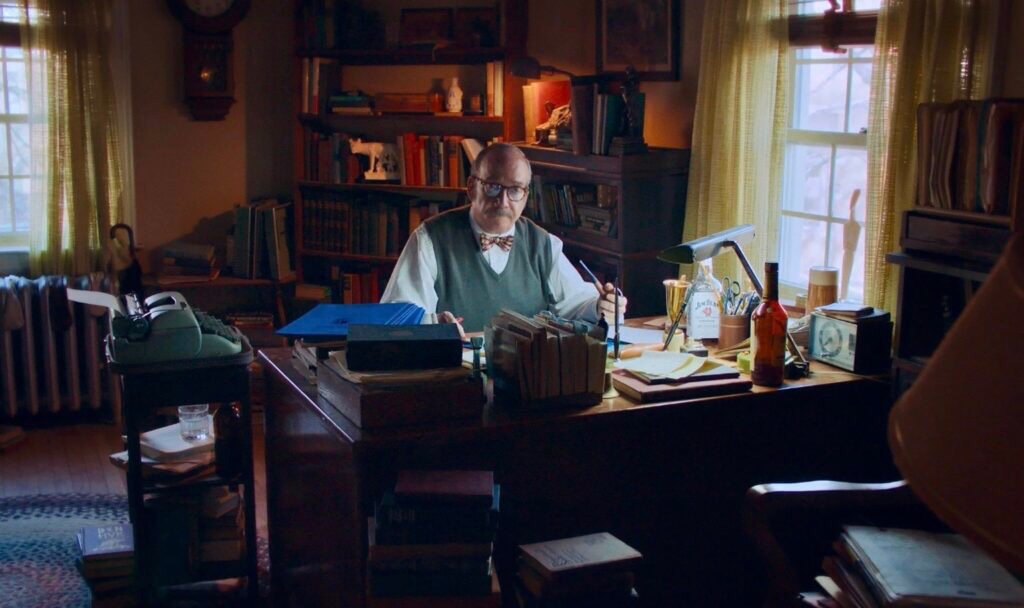
Who came with the idea of the silver Christmas tree at Lydia’s house? I liked the whole space age, Moon Landing remarks.
I love this, too. This was scripted, so it came from David Hemingson’s mind.
And what I find interesting about the scene taking place at Lydia’s house is that this is the only time we see one of the characters from Barton Academy outside that environment, showing a different side of their lives. And you are suddenly aware that Paul and Mary are very much the outsiders, while Angus feels good there.
Very good point, yes, that’s true. They have anxiety in this environment and Angus doesn’t want to leave.
The production designer also has to know every visual aspect of the movie, he along with the costume designer, set decorator and cinematographer, they are in charge with creating the look of the film. For cinematographer Eigil Bryld, this was also the first film working with Alexander Payne. How was your collaboration with him?
Eigil is one of a kind, he started later than Alexander and I and came in and fit in. He’s so talented, kind, and funny. Very easy going. He’s one of those guys who doesn’t say a lot, but when he does it’s either super wise or hilarious. Our collaboration was seamless, we all liked the same things and had watched so many of the 1970 films that we knew what look we were going after. Can’t wait to work with him again.
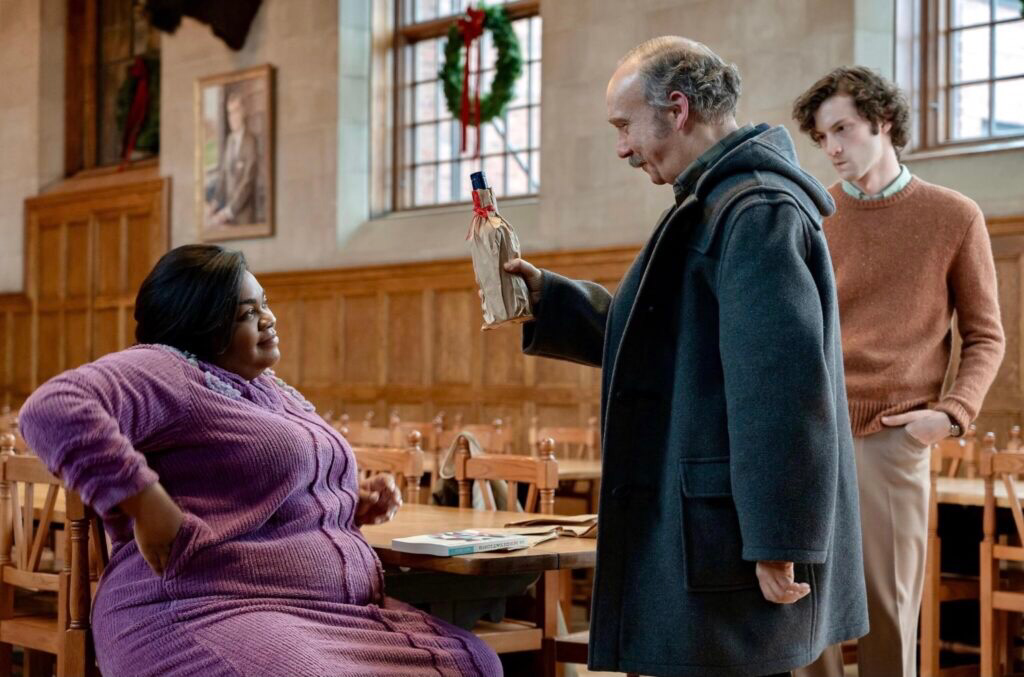
When Paul, Angus and Mary are having their Christmas meal and Paul is trying to cheer them up, Angus says he wants to go to Boston, because he wants a real Christmas, he wants to go ice skating, he wants to see a real Christmas tree, with real ornaments. And so they go on the “field trip” to Boston. And Paul does take Angus ice skating, he takes him to the cinema (which cinema was it, by the way?), to see Little Big Man, to the Museum of Fine Arts, to an outside lot of a bookshop. Were all the Boston locations scripted, or did you have to change any of them?
All of those Boston locations were scripted except one: the bowling alley. This scene was originally scripted as a winter carnival. When we set out shooting, we were limited in budget. Focus hadn’t bought the film yet, so we were having a hard time figuring out how to create a 1970 winter carnival, with period rides, and booths. While scouting, we stumbled into that beautiful bowling alley, which is like a time capsule. We loved it instantly and later Alexander and I were having a drink at the hotel bar, and wondered if it could work instead of the Winter Carnival. We called up the screenwriter, Dave, and asked if he could rewrite the scene for a bowling alley. The next morning we woke up to a new scene re-written for there, and the rest is history. I love how open Alexander is to allowing the outside world inform what we do, such a beautiful way to do it.
The exterior of the theater was shot at the Orpheum, which was showing films in Boston at the time. The interior was shot at the Somerville theater.
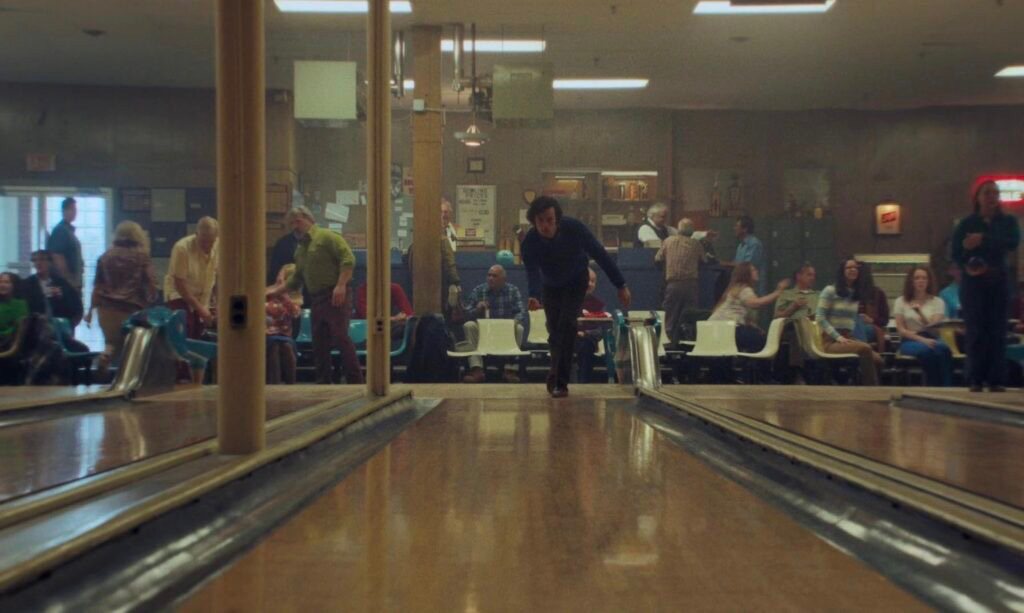
Speaking of movie theaters, what does the movie going experience mean to you? Do you have a favourite cinema, or a favourite movie theater you grew up with?
I love going to the movies. I’ve always gone to the movies alone, and it’s such special time. When I was young and broke, I would buy 1 ticket and see 4 movies. It was refuge. Growing up, there was a theater across the street from our apartment, the Lakes 6 theater in Tempe, AZ. I watched so many films here. So much of who I am now is because that theater was so close and accessible. Now my favorite theater to go to is the Hollywood Theater here in Portland, OR. I recently got to take my kids to see The Holdovers here, which was a very special experience for us all.
Are you feeling optimistic about the future of the movie theater?
I am. Here where we live in Portland, there are numerous privately owned theaters that are showing original prints of 35mm films, and making events of going to the Cinema again. And the theater is always packed. I believe after covid people are hungry for a shared viewing experience. I know personally it’s been a joy watching The Holdovers with an audience. I can’t imagine it any other way. This all gives me much hope that we can get back to this experience.
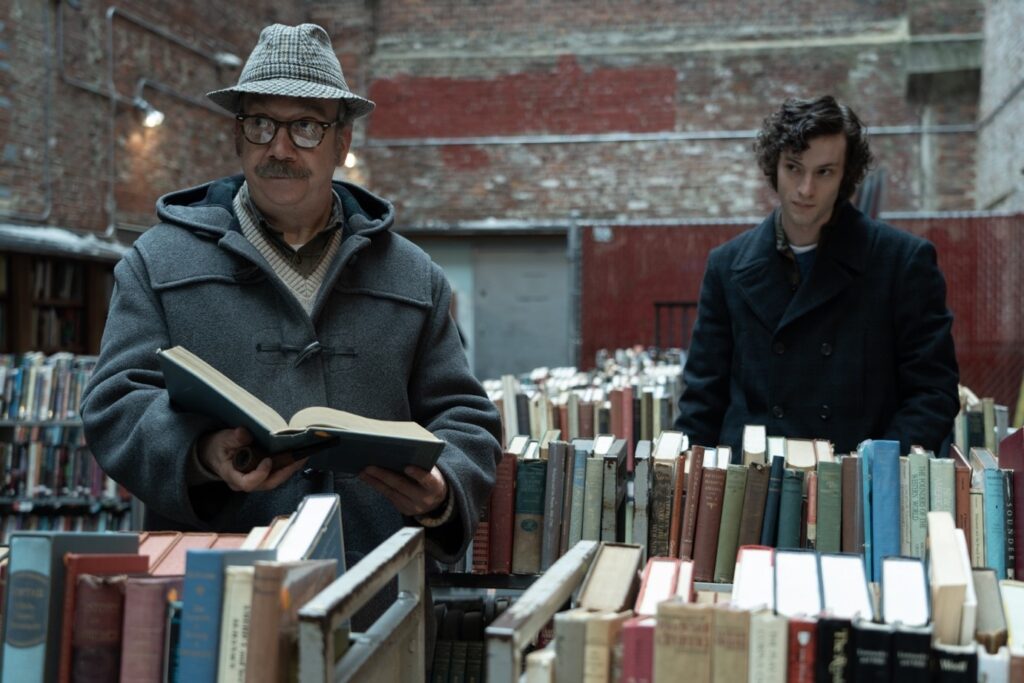
While doing research for the interview, I came across a podcast of The Brattle Book Shop, in Boston, where bookseller Kenneth Gloss talks very nicely about the crew and cast filming there and the way you transformed their sale lot and surroundings into a part of Boston’s gritty, bygone Combat Zone. Was it difficult to make Boston look like back in the 70s?
I love this book store so much. They were so kind and helpful. Alexander and I spent many days just walking around downtown Boston, looking for corners and sections that haven’t changed much architecturally. From there it’s just a matter of switching out signage, adding period set dressing into windows, and then dressing in snow and period cars. For the book shop, we had a team of people pulling non period books. This was a ton of fun. Difficult, yes, but so much fun.
I would like to confess that I love talking about all different details in the film, but what matters most is in fact that you aren’t caught up in saying “What a great set!”, or “What great costumes!”. You just become part of the story. Because the beauty of Alexander Payne’s films is that they are just like life, with drama, and comedy in them, and people who are not just acting, but reacting to each other. And when you watch Angus in that scene when he steals the keys from Paul and roams the school at night on the song of Labri Siffre’s “Crying Laughing Loving Lying,” you cannot help feeling that you somehow relate to him and that you witness something special.
This makes me so happy to hear. I love this part of the film. The sets, wardrobe, that beautiful song, and Dom all just fit perfectly together like a puzzle. I felt so lucky to be a small piece of what makes this all work. Like I said before, our work on the sets should never stick out or bring attention. So to hear you are able to just fall into the story is the best compliment I can get.
Thank you for your wonderful work and for holding onto craftsmanship in filmmaking. Do you know what your next film will be, if you are at liberty to say?
Thank you for writing about the artists creating films! I love what I do, and feel so lucky to be able to do it. I am currently looking for the next project to follow up The Holdovers. Alexander and I are trying to find the next project and I’m also speaking with James Ponsoldt about his next film, which would be a ton of fun and another 1970’s set piece. I continue to be picky and only take projects that speak to my heart. So we will see!
Please do continue to be picky. I will be looking forward to that next film!
***
ryanwarrensmith.com
